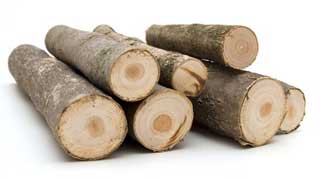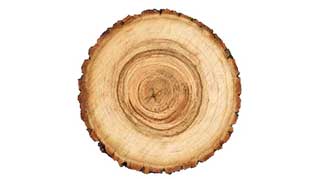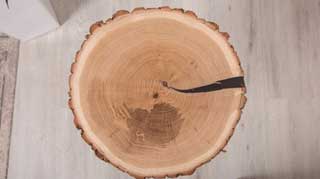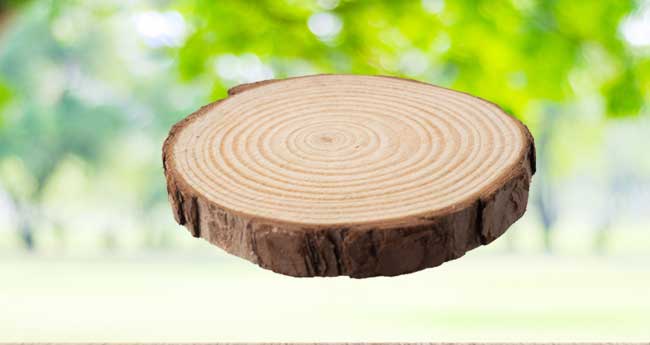A greenwood or a freshly cut wood is always prone to splitting. The first important thing to know is that it is the nature of wood and cracks happen because of natural causes. It doesn’t matter which wood you are using.
The main reason for splitting or cracking is a wood relationship to its surrounding environment. A greenwood with high moisture content will shrink relative to humidity in the air and similarly a wood with low moisture will swell up by absorbing more water. This happens because of equilibrium moisture content (EMC).
If you can maintain and balance the moisture of the wood, you can protect your greenwood from getting cracks. Let us discuss this in detail and discover ways for how to keep green wood from splitting
Why does green wood split and crack?

Greenwood can easily get cracked due to 100% moisture in it. Greenwood refers to a freshly cut wood that has not had any drying treatment. Drying treatment is the seasoning of a wood through which its internal moisture is reduced by evaporation.
Seasoned or dried wood only contains 20% moisture and is not prone to cracking. A greenwood gets more affected by its surroundings and temperature fluctuations.
Greenwood always tries to match with external temperature and environment. This process is called equilibrium. Whenever any fluctuation in temperature happens, wood tries to balance it and can get cracked.
Temperature and air moisture fluctuation in the atmosphere will cause wood to get dry or get wetter when trying to reach an equilibrium. If humidity is low, wood will also dry further and will split. If moisture in the air is high, the greenwood inner core will become wetter.
To better understand why cracks and splits happen in the greenwood, it is important to know about the water content in a newly cut wood (greenwood). It contains almost 50% of the two types of water that are naturally present there. These two types are free water and bound water.
Bound water doesn’t easily leave the wood as it has hydrogen bonding within the wood. However, free water is present in the capillaries of the wood and can be easily absorbed or removed.
As it is obvious that twisting, splitting, or cracking mainly happens due to natural causes, do not panic. Also, greenwood will always get cracked, it is not impossible to prevent and reduces cracks in the wood.
A thicker wood will always take more time to maintain moisture content because it will slowly remove or absorb moisture.
3 Method to Keep Green Wood from Splitting
If good care is not taken while storing greenwood, it is subject to get cracked and split. Following steps are necessary to keep green wood from getting cracked
- Keep all boards of greenwood wet and it is even better to store them underwater during summer and spring. This will help the wood to maintain its EMC.
- The orientation of all greenwood should be always selected carefully. Ends of logs that are oriented from east to west do not get damaged due to heating. While South to west orientation is responsible for heat damage and cracking. Sealing is the best option to prevent this while storing green woods.
- Use a hand garden sprayer and apply any fungus treatment on the wood. Only apply this on the open sides of the wood. This will protect the wood from getting mold and splitting.
- Always follow the instruction when using any kind of treatment or sealant. And always check if your wood is suitable for that specific sealant.
- Store and dry your greenwood in state of boards instead of logs. Boards are always less likely to develop any cracks.
1. Seal the Open Wood

Sealing material will prevent the wood from coming in direct contact with air moisture at the open ends of logs. This will decrease the dryness and shrinking of wood.
The best commercial sealant for greenwood is anchorseal. There are different versions of this sealant and are widely good for fresh and softwood, log cookies, and woodturning blanks. It is a hybrid consisting of wax and plant-based polymers.
Clean the wood surface from all dust particles and debris. Use a brush or a sprayer to apply this sealant on your wood.
Cover all the parts where sealants are required. While using a sprayer, always make sure to have 0.21”/0.55 mm tip or larger than that. If a plank of wood is thicker than 24″/60 cm in diameter, apply two coatings of anchorseal for a required result.
You can also pour anchorseal in a big tub and then dip your logs in it. After covering every inch, take the log out and remove any access. Let the sealant dry.
There are many other sealants in the market and always choose a one that is more suitable for your wood. Remember if you want to store your woods for just a few months, cheap sealing materials can do this job very well. But if you want to store your woods for more than a few months, always look for an expensive and strong sealer.
2. Paintable Wax
A DIY wax is also a good way to protect your wood from drying and cracking. This is very cheap and effective while working on a greenwood. You will need the following material:
- Any Paint Thinner
- Wax Candles
- Hammer
- A canning Jar
- A food Scale
Use a large number of wax candles and place them all in a plastic bag. Now, break all the candles into very small pieces with the help of a hammer. Put this plastic bag on a food scale and take measurements in ounces. Preheat a saucepan or a pot and put all these candle pieces into it. Keep heating the pan until these candles fully melt.
Take a canning jar and add paint thinner. Quantity of paint thinner should be equal to one-fourth of the measurements of a plastic bag filled with broken candles. Now add melted wax into it and shake gently to make a blended mixture.
Apply a thin coat of this home-made sealer to your greenwood open ends or where you want to seal the wood. It is best to use a brush while applying this sealer.
While making this Wax, always keep a paint thinner away from any stove or fireplace. It is important to know about wood nature and to read all guidelines on a thinner before using it.
3. Boiled Linseed oil
The main use of linseed oil is applying it to woods to guard it against splits and cracks. This method is very easy and requires a few steps. First, sand the wood. Sanding should be done in the direction of wood fibers.
If you are storing your wood in board shapes than you have to sand the entire surface of the wood but for long woods just try to sand the open ends. Be careful while sanding your wood as it is a very important process while preserving your wood.
After sanding your wood, apply boiled linseed oil on it. Place it under a non-sunlight open air. Wait for it to dry!
Remember to not expose your wood to sunlight after applying linseed oil, as it will be too harsh for your wood. The other very important thing to remember is, always make sure that you have cleaned all sanding spots of dust particles before applying linseed oil sealer.
Tips for Preventing cracks in greenwood

It is always a difficult task to work with green wood but can be a very refreshing work at the same time. The freshness of these greenwood brings you peace and you feel more alive.
If you are carving green wood and are not sure about what to do to prevent your wood from cracking, the following are all the strategies that you can apply while working on your project.
1. Keep the Wood Wet
While working on a greenwood project, it is important to keep wood wet from outside. This means to control the wood’s moisture. If the outer layer of wood will get dry too quickly, wood will shrink. Inner wood will be still wet due to water and will cause the outer layer to crack.
The outer layer of wood becomes quickly dried because of the process of evaporation. So, it doesn’t matter how long a carving process will take, some quantity of water will always evaporate. That’s why you have to keep your wood wet from outside.
Use a sprayer to dampen the surface of the piece you are working on. If you are going to take a break or your working time is over, it is necessary to lightly spray the wood piece which is still under carving progress.
Cover it with a plastic bag. This will cause the inside moisture of wood to move towards the outside dry layer. It happens because wood always tries to maintain its balance of water and will always seek an even distribution.
Remember that wood inside plastic for a plastic bag for too long will grow mold. Remember to remove the plastic bag first before start working again and replace it with a new one.
2. Choose Your Green-Wood Carefully
There are various types of green woods and they all have specific uses. It’s better to know which wood will benefit you the most.
The best wood to avoid any cracks is the one that is native to your area where you are residing. Always know about climate changes and how the wood will react to the external environment.
Harvest your wood if it doesn’t require a lot of traveling or any big investment. In this way, you will have full confidence in your green woods and will prevent the cracks in the best possible way.
Remember, if you are looking for certain species of green wood that will not get twisted or cracked easily, it is worth the effort to invest and to search for harvesting locally.
If you cannot harvest your desired greenwood, go to local lumber mills and search for it. Through the careful approach, you can get a very high -grade green wood having very few chances of cracking at a very low price.
3. Use the wood as soon as possible

It is recommended that you start a carving project with green wood right away. Greenwood will always be very soft and flexible.
To prevent it from splitting, use it as soon as possible. Longer you wait, more it will get dried and the risk of cracks will increase.
Try to cut them in long lengths and round shapes as it will help to maintain the moisture of wood.
Conclusion
From all our research on how to keep green wood from splitting, it is clear that we cannot just expect a greenwood to not shrink or crack because of wood nature.
However, cracks and splits can be reducing and repaired by applying the above methods and taking precautions while working with them.
We will recommend to choose your woods carefully and apply the best strategy according to your wood requirement. Before choosing any method, make sure that a specific product is available in your area. Always prefer to store wood in the board state.
Best of luck!

